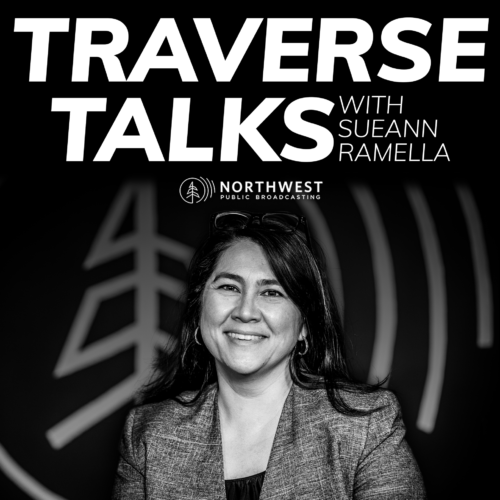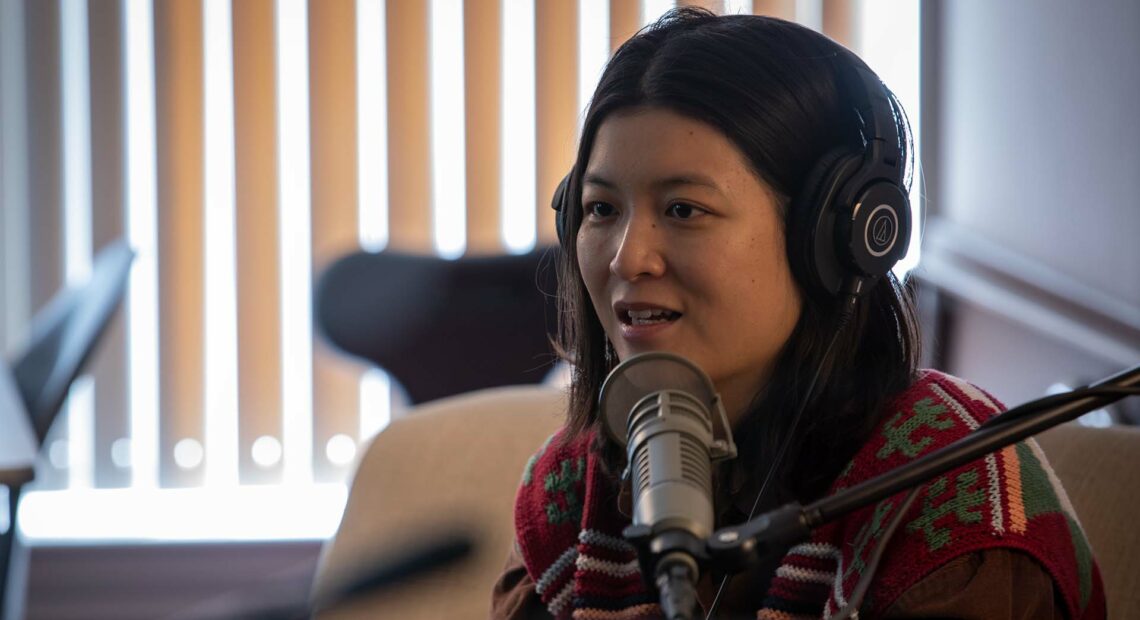
How Does Art Connect Us? ‘Traverse Talks’ Episode 31 – With Artist Jiemei Lin
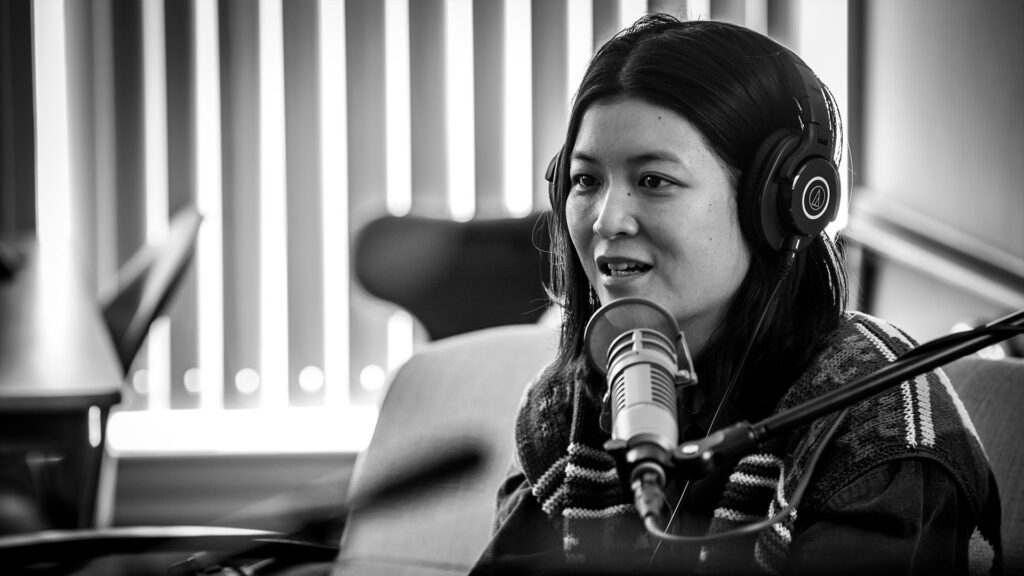
Born in Hangzhou, China, Pullman-based artist Jiemei Lin has made a home and a name for herself in the inland Northwest. A creator of both digital and physical art, she has public art showcased in Pullman, Spokane and other cities. In this episode of Traverse Talks with Sueann Ramella, Jiemei Lin explores a wide range of topics – from an artist’s perspective on the digital world, to her relationship with her grandfather, to cultural identity and Asian hate. What’s the relationship between artists and social media? What did her grandfather teach her about feminism? What does it really mean to be American? Listen to find out.
SUBSCRIBE: Spotify / Apple Podcasts / NPR One / YouTube
Listen
Conversation Highlights:
Discerning Meaning In Art:
Sueann Ramella: I feel artists have been [working hard] too, on an emotional level, trying to express something for people to meditate on and feel better or at least, I don’t know, explore some hidden things inside.
Jiemei Lin: Yeah. I guess. Or just, I think for like public art – that’s something everyone can see and it’s free, right? It’s huge. And everyone owns that piece of art, you know. When you see a piece of art, you are part of it because you project yourself on it and then you become part of the work. That’s why I like to make public art because I feel it’s very inclusive.
Sueann: Oh, that’s beautiful. I guess I never really thought about my involvement in being with that public art piece. And now I will.
Jiemei: Well, so, this is so funny, but a lot of people ask me, “Oh, so I went to the museum. I just feel so bad because I cannot understand the art.” And I thought, you know, maybe that’s just how you feel about it: “I’m confused.” “I feel confused.” “I can’t understand.” And that’s how you feel about it. And then you’re part of it [in feeling] confused about it. Or sometimes people feel like, “Oh my God, it’s so disorganized. I feel to discomfortable when I see this painting.”
Sueann: That’s part of it.
Jiemei: Yeah. That’s part of it.
Sueann: Oh, this is interesting ’cause I almost wonder if the general public has not really been educated on how to experience art, that it is okay to have all these different feelings.
Jiemei: I feel it’s so easy for people to feel music, like when you listen to a piece of music, when you listen to a song, and you just immediately feel, “Oh, I feel sad. And I feel so connected with the lyrics.” Actually, you are doing the same thing to the arts, but it’s just so hard to describe it, I guess, because music maybe, like, it’s more natural to us? I don’t know exactly, but I think they are the same feeling.
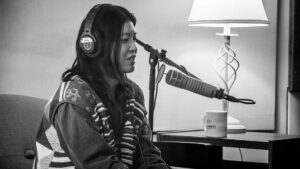
Shoulders rounded, Jiemei relaxes into the conversation with Sueann.
Sueann: For me, it’s just a lack of training. I have not been exposed to many art pieces. For you though, when you make these large public murals, do you have an intent for a feeling you want people to have?
Jiemei: So it depends. Like for example, I did the Black Lives Matter mural in Pullman, so that piece, it says, “End Racism Now,” so that’s [a] very direct message. But for like a more abstract pieces, like I did another one in downtown with all these little cubes.
Sueann: Yes.
Jiemei: So that one, you can feel whatever you want because what I did [was] I just tried to play with the space, play with the architecture of the hotel building and see what I can do. See if I can create more space and more elements.
Art In The Digital World:
Sueann: So I have a question about tech stuff, because I notice that your artwork is, I mean, you do computer, you do all kinds of things. So in a rapidly changing digital landscape, do you think we’ll start to find less physical artwork and more things in the virtual world?
Jiemei: Well, okay. So here’s my answer. I don’t think the physical stuff will ever be gone because just like making music, that’s just part of us being human beings. And there will always be people [who] truly appreciate doing things with your hands. But on another hand, even though doing things on digital media feels like you are not working with your hands, it’s very handy too. Like, it’s just different tools, you know? Let’s say like Andy Warhol. So his concept pretty much, he’s thinking of, “Okay, so we are going to live in a world [where images] will be copy and pasted. Now stop and put it on different things,” right? Definitely he predicted this world we are living in right now, but [at] that time, the technology for him was printmaking, like a silk screen. So what he could do was just keep copying and pasting things on the printmaking. Well, his stuff now is copy and pasted on, you know, social media all the time. And that was part of his intention as well, right?
Sueann: Yeah.
Jiemei: So my point is it’s all tools. Like a brush is a tool. Photoshop is a tool. But the real question is how we display art or like how we share art with each other. I feel like now it’s so tricky because all the artists feel pressured. They have to be on social media and keep posting their work and keep promoting themself. And I feel like every artist is forced to be a marketing person now, in a weird way. And then we are all doing, like, free labor for Facebook, Instagram, and I feel they’re so evil. And I feel so bad, but then I also feel like I don’t have another way to-
Sueann: [To] show your work.
Jiemei: Yeah. So I feel it’s very complicated.
Sueann: You are indentured a bit to the social media in order to showcase your work.
Jiemei: Yeah.
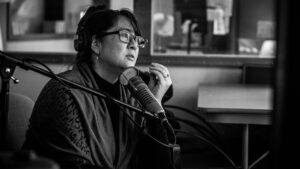
Sueann leans forward, empathizing and engaging with Jiemei while asking a question.
Sueann: And then, I’m curious, does that make you not want to put in that energy? I always assume that an artist gets a feeling or a muse or some inspiration and you create out of this feeling, but then the thought of having to put in the marketing work to promote your art could suck away from that intent.
Jiemei: For sure. Yeah. I just couldn’t stop thinking about this idea of, like, we are doing free labor to those social media companies by showing my work on it. But for a digital media artist, for an illustrator, I feel like that’s truly one of the best ways to put myself out there.
Sueann: It’s quick and easy.
Jiemei: It’s quick and easy and it seems like it’s free, but it’s definitely not free. And I just try my best to keep this balance, to make myself [not] feel like I’m working for Instagram.
The Things We Inherit:
Sueann: Can you tell us the story about your grandfather and the significance of indigo?
Jiemei: So my grandfather is, so now when I think of him, he was [a] very complicated person to me. When I was young, I think he was probably the first artist I ever met. But at that time, I didn’t have the language; I didn’t know what he did was art. So I would find all these, like, little pieces of paper – in the bathroom and every corner of his house – and there were poems written on [them]. And pretty much he just [was] like walking around and then he had this idea and wrote it down and he just put the poem over there, like right on the table, like on top of the toilet paper holder. It was just super random. And for some reason, I picked up that skill. So I started making little drawings everywhere in the house as well. So you can find like the side of the newspaper, there will be a little drawing there, here and there.
Sueann: This sounds delightful.
Jiemei: Yes, it is. It is. It’s very interesting. And I would always appreciate that. I would always appreciate that influence he’d given to me, which is like, when you feel like [making] something, make something, you know?
Sueann: Do it.
Jiemei: Do it. It can be very small. Nobody will read it. It’s fine.
Sueann: And Mei, your grandfather, he was a part of the Chinese Revolution, or he was a protestor?
Jiemei: He was, like, super radical. So he started publishing a lot of writing, like very, very critical and very, very radical writing [in] the newspaper. And that definitely got him into trouble at the beginning of the People’s Republic of China. Because [at] that time, the government was like very sensitive about the message. So him and his brother, his younger brother, they were both very, very smart and very radical and they were writing stuff and [publishing it in] the newspaper. And they got into trouble. And so they had to, like, change their names. And so my grandfather picked his name, his name is Lin Qin. Qin means indigo and his little brother is Bai, Lin Bai, and Bai means white. So there’s a phrase in China, it’s, “Indigo and white, nothing to hide.” So they wanted to tell people that they’re completely honest, that they have nothing to hide.
Sueann: Wow. Thank you for sharing that story about your grandfather and indigo. Your artwork, you have quite a few pieces that do indigo and white.
Jiemei: Right.
Sueann: Is it directly related to your-
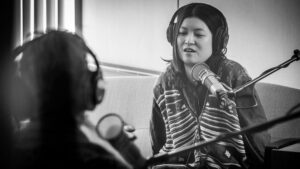
Jiemei mulls over her answer as she chats with Sueann.
Jiemei: Yes. Because I feel like he probably was one of [the] very first person taught me what feminism was. Well, my grandmother was like a working mother and my grandfather lost his job because he got himself in trouble. So he was like a stay-at-home dad for a long time. He keep telling me, “Hey, your grandmother was amazing. Like she was so strong and so independent and she worked so hard for everyone and you should be like that. Every woman should be like that.”
Sueann: Mei, that’s beautiful.
Jiemei: And also he told me that, “Oh, you know, I given you a generation name, and not every girl has it because people don’t believe girls belong to the family because they will be married to someone else.”
Sueann: Yeah. Let’s talk about that for our listener. Because in Chinese culture, generational names, you have Lin.
Jiemei: Yeah. Some old family, they do that. Like they have these generation names. Usually it’s in the middle of the name. For example, my name’s Lin, Jiemei Lin, it’s my family name, and Jie is my generation name. And then Mei is just kind of a given name.
Sueann: Your given name. Yeah. And it is unusual because women were not given this generational name.
Jiemei: Right. Because I supposed to be a Hedges because I will be married to this Hedges guy. But my grandfather, he told me, “You will always be Lin. You will always be in this family. And we’re giving you this name.” And he said, “You are always your own person.” That’s amazing. But at the same time, he would also, like, I remember when I just got married and he wrote me this super long letter about, like, “It’s terrible you married to someone who’s not from your culture.” And then like, “If you got into trouble, nobody will help you because everyone will be American around you. They will never understand you.” He wrote me a letter like that.
Sueann: Complicated person.
Jiemei: Yes.
Sueann: Because in some areas he seems progressive and in other areas he seems old fashion and difficult, but isn’t that the case with everybody?
Jiemei: Yes. That’s exactly the reason why I made all this artwork for him. Because I feel like the way he feel about me, I feel like he projected a lot of himself on me when I was young. And he wanted me to be this person he probably [felt] like he couldn’t be. But then when I actually started doing certain things, he realized, “Oh, no, she’s my little granddaughter.” Like, “How could I just put her to a world like this?”
Sueann: So a protection.
Jiemei: Yeah.
Sueann: I often think about that with our loved ones, is even though it seems really hurtful what they’re saying or doing, I wanna believe it comes from a place of love that they don’t know how to break through some of these barriers.
Jiemei: Yeah.
*Question and responses were edited for length and clarity.
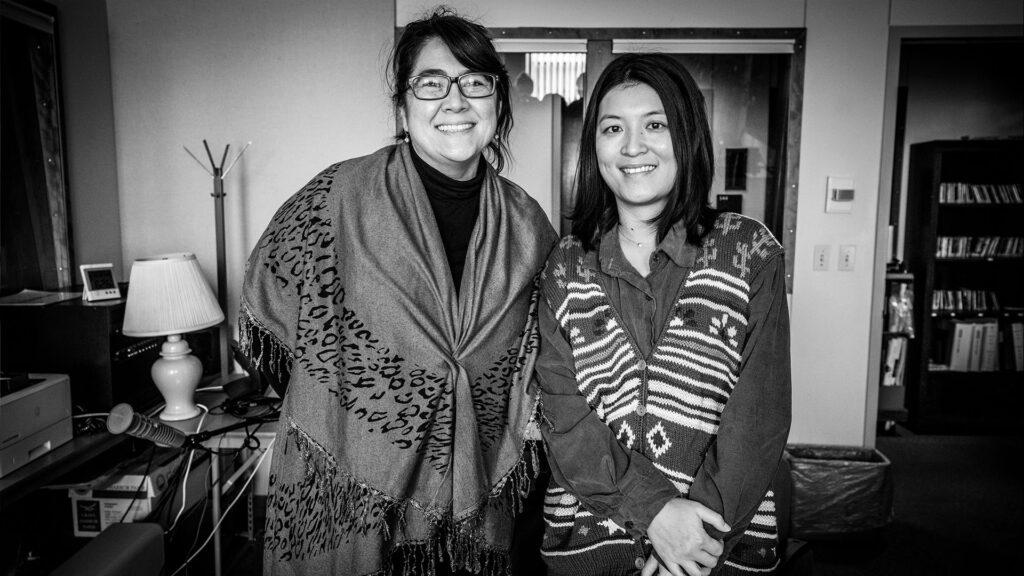
Related Stories:

Captive Returns Home: The Story Of Wetxuuwíitin – ‘Traverse Talks’ Episode 42 – With Chairman Samuel Penney
Photo of Sam Penney recording Traverse Talks at the Nez Perce National Historic Park on March 10, 2022. Imagine a stranger took your family’s heirlooms and then offered you an
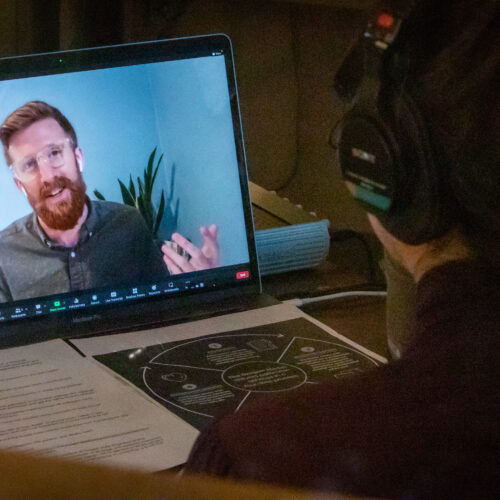
Psilocybin: Psychology, Policy and Possibilities – ‘Traverse Talks’ Episode 41 – With Sam Chapman
Sueann Ramella interviews Sam Chapman virtually on April 19, 2022. What do you really know about psilocybin, commonly known as magic mushrooms? Research on the substance has lagged behind in

You Inherited A House Full Of Stuff. What’s Next? ‘Traverse Talks’ Episode 38 – With Estate Services Owner Rich Old
Rich Old recording this episode of Traverse Talks on March 3rd, 2022. Grieving the loss of a loved one is already hard enough. To make matters worse, many people have

